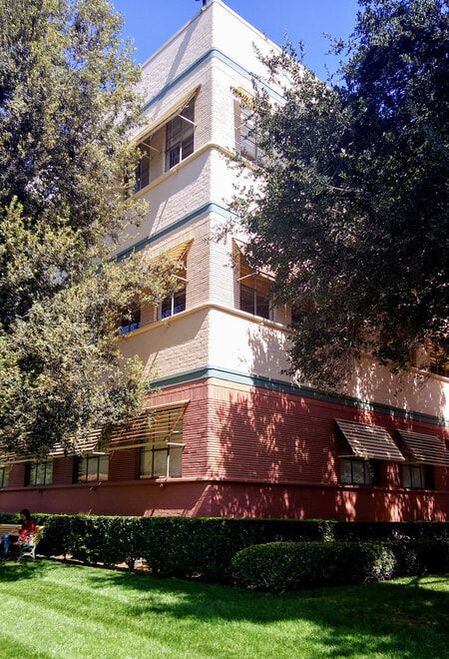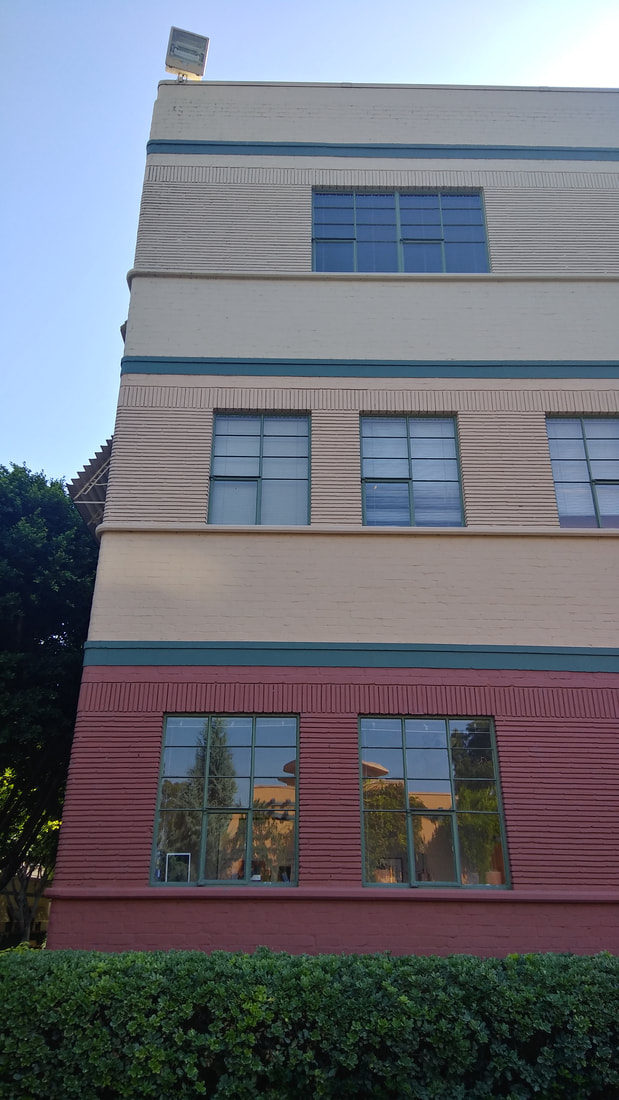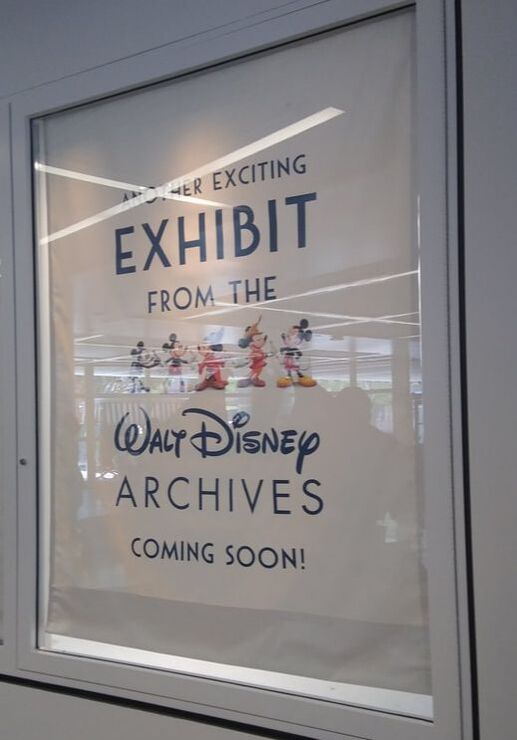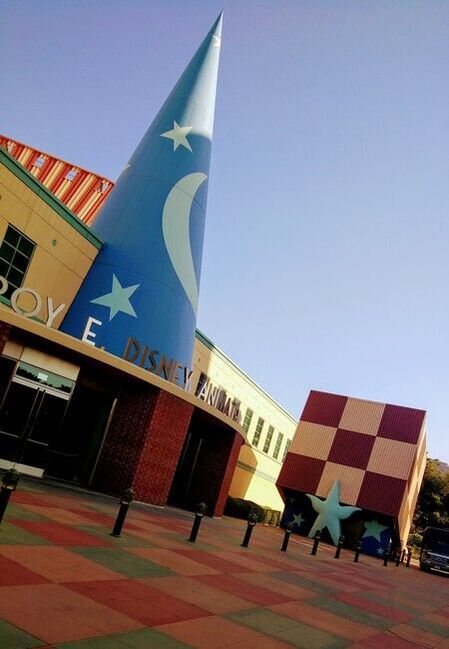|
I had the honor and privilege of touring the Walt Disney Studios in Burbank. The lot is very large and everyone is very friendly. Upon arriving at the gate, I was given a personal security I.D. photo badge. Walking the lot surrounded by the original historic buildings where all of the creative animation has taken place, is quite overwhelming. I took a lot of photos during our 3.5 hour tour, as you can imagine. I experienced so many emotions during the tour, there is truly a great amount of information to take in during that time on the studio lot. I felt when writing this post, it was best to stick to facts and reserve my emotional input at the post conclusion. The following historical facts are all from Wikipedia. A popular point of interest for studio visitors is "Pluto's Corner", outside the Animation Building's A-Wing at the southwestern end of the block. There one can see three paw prints embedded in the street, curbside beneath a fire hydrant. A hind paw print is missing, humorously suggesting that Pluto used the hydrant to mark his territory. Nearby is the often-photographed signpost indicating the site's location at the corner of Mickey Avenue and Dopey Drive, with directions to various studio departments as they existed in Walt's era. (Today only the street names remain the same). According to longtime Disney archivist Dave Smith, the street sign – the only one of its kind on the Disney lot – was installed as a temporary prop for the "Studio Tour" segment of the Disney feature The Reluctant Dragon (1941) and never removed. One of the most famous Disney intersections is Mickey Avenue and Dopey Drive. Pluto's Corner meets in-between with Pluto's paw prints and a red fire hydrant. Down Dopey Drive is the original commissary. Inside the Buena Vista Cafe are multiple food stations serving hot and cold food. This private cafeteria and grill opened in 1940 as Walt Disney's Studio Restaurant, and is now named the Buena Vista Café. Along with Stage 1, the Cutting Building, and the Main Theater, it is one of the few original buildings on the Burbank lot still serving its initial purpose. The commissary offers breakfast and lunch options for studio employees and guests, with indoor and outdoor seating. It once had an executive dining area called the Coral Room where Walt Disney occasionally lunched. The site was extensively remodeled in 2011, the Buena Vista Café is currently open Monday through Friday from 7:00 AM to 4:00 PM. The grill shuts down at 2:30 PM; pre-packaged foods, snacks and beverages can be purchased until closing time. I had heard about Walt's famous chili and couldn't wait to try a bowl! It was mild and delicious. The recipe was found in Walt's personal files in the Walt Disney Archives (he last revised the recipe on March 25, 1958). The three-story former main building for Walt Disney Animation Studios was completed in 1940, based on a Streamline Moderne design by industrial designer and architect Kem Weber. It is considered the jewel of the original studio buildings. Walt Disney personally supervised the eight-wing "double H" design, ensuring as many rooms as possible had windows, which allowed natural light into the building to help the animators while working. Many Disney animated features were drawn here, including Dumbo (1941), Bambi (1942), Cinderella (1950), Alice in Wonderland (1951), Peter Pan (1953), Lady and the Tramp (1955), Sleeping Beauty (1959), One Hundred and One Dalmatians (1961), The Jungle Book (1967), The Aristocats (1970), The Rescuers (1977), and The Fox and the Hound (1981). The animation for The Black Cauldron (1985) was the last to be completed at the site. The Animation Building initially served as the creative and administrative nucleus for the entire studio. Walt's brother Roy O. Disney, who ran the company's financial operations, shared a wing with the accounting and legal departments on the first floor, which was where the animators, in-betweeners and clean-up artists worked. The D-Wing's ground floor was the longtime domain of Disney's Nine Old Men, and over the years other prominent animators and artists such as Bill Tytla, Fred Moore, Norm Ferguson, Preston Blair, Eyvind Earle, Tyrus Wong, Mary Blair, Andreas Deja, Floyd Norman, John Lasseter, Glen Keane, John Musker and Ron Clements worked in the building. On the second floor were office suites for the directors and studios for the background and layout artists. The story department was located on the third floor, along with offices and a rehearsal room for Disney's composers and arrangers. A little-known feature of the Animation Building was its private rooftop annex, The Penthouse Club, a perk for male employees who could afford its membership fees. It had a gymnasium run by a full-time athletic instructor, a bar, a barber shop, steam baths, massage tables, pool and poker tables, and an outdoor patio which members tended to use for nude sunbathing. The entrance displayed a mural painted by animator Fred Moore depicting a bevy of nude or semi-nude women, surrounding a drunken single man bearing a certain resemblance to Moore himself. By the early 1960s the gym activities had ceased and it became a casual lounge for studio veterans. The Penthouse space has been shuttered for years and the Fred Moore mural removed to an unknown location. Suite 3H, on the third floor of the Animation Building's H-Wing, was Walt's headquarters. The five-room space included his two adjacent offices: a "formal" corner office for signing contracts and meeting with important visitors, and a "working office" where he huddled with key staff to develop ideas for his films, television shows and theme parks. The latter had a kitchenette hidden behind wood paneling that retracted at the touch of a button, as Walt often ate lunch at his desk. Also in the suite was his secretary's office, featuring displays of his numerous awards, and a lounge area where Walt would relax after 5:00 pm with a drink (Scotch Mist was his cocktail of choice) and a back massage from the studio nurse before going home. Walt's suite was closed after his death in 1966 and not reused until 1970, after his personal items had been carefully archived. Over the years these items were used in museum exhibits recreating his offices, primarily at Disney resorts. In 2015, under the auspices of the Walt Disney Archives, Suite 3H was restored as closely as possible to the condition in which Walt left it, with many of the original furnishings and objects. Walt Disney Company CEO Bob Iger dedicated the restoration on December 7 of that year. In 2016 it was opened for viewing by studio employees, special guests, and gold members of the Disney fan club D23. The basement housed the Test Camera Department, which shot test loops of animation drawings in progress. Animators and directors would view these loops on Moviola machines to check the work before submitting it to Ink and Paint. A utility tunnel linked the Animation Building with the neighboring Ink and Paint Building and the Camera and Cutting departments. It was built to ensure that the original animation drawings and painted cels could be safely transported from one location to another without being exposed to bad weather or other outside elements. The tunnel is still maintained and a length of it is open to D23 tours. Here I am with my wonderful tour guides: Robert and Louis. Directly across from the Animation building is the Theatre. Currently, (at the time of this post) Maleficient was playing. The 419-seat Theater, another original building on the Burbank lot, shows first-run Disney films for studio employees and guests. It has plush stadium seating and has been upgraded over the years to keep pace with new technology in the exhibition of films. Food and drink are not allowed inside. Throughout its history, the theater has also been used for post-production sound mixing. According to the Disney production services website, "The Main Theater is a state-of-the-art digital sound dubbing and screening facility that was first used to mix the sound for Fantasia [in 1940]. Sound mixers blend dialogue, music, and sound effects tracks to the various levels appropriate for a movie theater. The acoustics are designed to simulate a theater that is three-quarters full. Although the theater is empty during the mixing session, extra padding in the seats and specially designed walls absorb and reflect the sound. This helps the sound mixers to know what the final product will sound like when it is released to the public." The signage above the entrance says simply "Theatre". The name "Main Theater" is used to distinguish the venue from several smaller screening rooms situated throughout the studio. In Walt's era these were called "sweatboxes", where animation test reels and the daily rushes of his live-action features were shown for his approval.  Completed in 1939 at a cost of $300,000, the Water Tower was one of the first structures to emerge at the new Disney studio. It stands 135.6 feet high and originally held 150,000 gallons of water. Towers such as these provided an emergency water supply in case of fire and were a standard feature of major Hollywood studios of the era. Roy Disney, however, insisted that the Disney Studio's water tower be built with six legs instead of the usual four, claiming it was more aesthetically pleasing. The tower is no longer used for water storage and stands as an identifying symbol of Disney's Burbank studio. In 1984 the top portion of the holding tank was painted white and, for the first time, emblazoned with the image of Mickey Mouse, the official mascot of the Walt Disney Company. In the Disney Legends Plaza is the statue of Roy O. Disney and Minnie Mouse, designed by Imagineer Blaine Gibson. It is the same statue found at the Magic Kingdom park in Florida. Dedicated on October 18, 1998, the plaza features the Partners statue of Walt Disney and Mickey Mouse. This statue is the same found in Disneyland park's central hub just in front of Sleeping Beauty Castle. This Partners statue is accessible and I was overwhelmed standing next to my heroes there in Disney's Legends Plaza! Near the Water Tower is a map of the studio lot. The Hyperion Bungalow was built in 1935 as the original home of the Disney Publicity and Comic Strip Departments. It was constructed at the Disney Studios on Hyperion Avenue in Hollywood and moved to the Burbank location as part of the construction process in 1939–1940. At the Disney Burbank lot, the building housed many support services over the years. Payroll, Publicity Support, Traffic and finally the Post Office were located in the building. The structure is the last remaining example of the "California Bungalow" type architecture that remains from the Hyperion studio facility. Its attractive style and utility, dating back to the early years of the company, give it a special place in the history of the Disney lot. This building is dedicated to the former President of The Walt Disney Company from 1984 to 1994, Frank G. Wells. The building opened in 1998 and was dedicated by Wells's widow Luanne Wells, and company CEO Michael Eisner. The five-story building has a usable area of 240,518 square feet with three underground parking levels, accommodating 600 parking spaces. The construction was completed in two phases: phase I in August 1997 and phase II in July 1998. The Frank G. Wells building was specifically designed for Walt Disney Television Animation, and the division formerly had offices located on the third floor. The division has since moved to the Grand Central Creative Campus in nearby Glendale, California. It is distinctly recognizable through its giant movie reel and film strip on the building's exterior. The Disney Archives were closed for the day due to updates. Home to the Walt Disney Archives, studio mail center, Marvel Studios, the Disney Music Group, a screening room, various multipurpose rooms, and one of the three extant multiplane cameras (which is on display in the lobby). It was formerly home to Walt Disney Television, various management offices, and the human resources department. The Archives are located on the ground floor and are open to all cast members; they also have additional storage and restricted areas on other floors. The Studio's Starbucks Coffee shop is also located on the ground floor. The 1940 Ink and Paint Building was where animators' drawings were inked onto transparent cels and then the cels were painted. It was built with high ceilings and a sophisticated central ventilation system so that the staff members would not be overcome by toxic paint fumes. One section was used as a special paint-mixing laboratory to provide Disney cartoons with the widest possible spectrum of colors. Three interior courtyards provided northern light for the artists and also served as outdoor break areas. It was a self-contained structure with its own cafeteria, lounge, and rooftop sundeck. The basement of the Ink and Paint Building was the location of Disney's famous "Morgue", where artwork from the studio's films was stored for possible future use. In a 1957 episode of his Disneyland TV series, Walt took viewers into the Morgue and, after some ghoulish fun on the room's name, explained its real function. In 1989 this archival material was moved to its current location at the Disney Animation Research Library in Glendale, California. Technological advances in animation, such as the advent of Xerography in the early 1960s and the development of CAPS in the late 1980s, ultimately made traditional ink and paint techniques obsolete at the Disney studio. The last Disney animated feature to employ inked and painted cels was The Little Mermaid (1989). Today the Ink and Paint Building is primarily used for office space, though its original paint-mixing lab has been preserved and is used for the creation of limited edition Disney artwork created on-site. Another original site on the Burbank lot, it is the longtime home of Disney's editing facilities. The building's name derives from the traditional method of physically cutting and splicing films shot on nitrate and (after 1952) safety stock. Today it employs video editing techniques. The Camera Building, built in 1940, was where animation backgrounds and cels were traditionally photographed onto film. Unique original features were the "de-dusting chambers" that personnel, painted cels and other materials had to pass through before entering, so no trace of dust or lint would show up in the photography. In 1941 it housed two multiplane cameras, each standing 12 feet high and occupying its own room, and two conventional camera set-ups. A third multiplane camera was subsequently constructed. Since 1990 the Camera Building has been occupied by what is now Buena Vista Imaging, which provides photo-optical and digital imaging services for films and television. The two-story Shorts Building is one of the most significant remnants of Disney's former Hyperion studio. It originally consisted of two buildings, constructed in 1934 and 1937, to accommodate the company's rapidly expanding animation department. The 1934 structure was called the "Animation Building No. 2" and Walt and Roy Disney had their offices there prior to the move to Burbank. The animation for scores of Disney shorts of the 1930s, including The Band Concert (1935) and the Oscar-winning The Old Mill (1937), was created in this complex, and it was here that Walt hatched his risky idea for America's first full-length animated feature, Snow White and the Seven Dwarfs (1937). In 1939 the two buildings were disassembled, transported to Disney's new Burbank lot, and reconstructed as a single T-shaped edifice, with the addition of a loading dock. (The window of Walt's old second-floor office can be seen directly above the dock). The colloquial name "Shorts Building" was apparently a nod to its historical past, as no further animation would be done on the premises. Since its relocation the building has served the studio in support capacities, housing the publicity, comic strip, foreign relations, hair and makeup, and wardrobe fitting departments. The lot's Studio Operations department is now located here. Stage 1 was completed between 1939 and 1940 and is the original Disney soundstage on the Burbank lot. The soundstage was designed to replace a smaller stage at the former Hyperion Avenue Studio. Although Walt Disney Studios predominantly made animated films, the soundstage was built in order to film Leopold Stokowski's segments in the 1940 film Fantasia. During World War II, the stage was used for repairing army vehicles. The soundstage was formerly dedicated to Fantasia, for it being the first motion picture that was filmed in the building. The stage is the smallest on the lot at 11,000 sq ft. It features a 2400 sq ft underwater tank and is still in active use. On June 24, 2013, it was dedicated to Mousketeer Annette Funicello as it was the original shooting stage for The Mickey Mouse Club. Constructed from 1947 and opening in April 1949, Stage 2 is the second oldest soundstage on the Walt Disney Studios lot, and at 31,000 feet, one of the largest in Los Angeles. It was built and financed between a joint agreement between Walt Disney and director Jack Webb, who used the stage for the filming of the television series Dragnet. In October 1955, Stage 2 began production on the first series of The Mickey Mouse Club. From 1954 to 1955 and prior to the opening of the facilities at Glendale California, WED Enterprises (now Walt Disney Imagineering) occupied soundstage 2 to build multiple attractions for Disneyland, including the Mark Twain Riverboat. Since then Stage 2 has been used for filming of multiple attractions for Walt Disney Parks and Resorts. During the filming of Armageddon the filmmakers discovered the 40 feet high tall stage was not tall enough to hold one of the "asteroid" seen in the film. The floor was removed and an additional 20 feet was dug down to accommodate the 360-degree set for the scene. In 2001, soundstage 2 was dedicated to English actress Julie Andrews, because parts of Mary Poppins and parts of the then-current filming of The Princess Diaries took place inside this particular soundstage. Formerly known as the Walt Disney Feature Animation Building, the Roy E. Disney building is the current home of Walt Disney Animation Studios, which sits to the south across Riverside Drive. It was designed by the firm Robert A.M. Stern Architects. Construction was completed in 1994. As noted above, in 1985, Disney Animation was moved out of the studio lot and into a cluster of old buildings in Glendale. During Michael Eisner's 1986 restructuring of The Walt Disney Company, the studio's animation division was spun off to officially create Walt Disney Feature Animation as a separate subsidiary of the company, and in 1995 it came back to Burbank when its new home opened. The new studio is a colorful architectural landmark, adorned by a giant version of the Fantasia Sorcerer's hat, which once housed the office of Roy Disney, former head of Walt Disney Animation Studios. It also displays the word "ANIMATION" on giant letters on its south side to passersby on the Ventura Freeway. In 2009, following the death of Roy Disney, the building was renamed and rededicated in his honor by Disney president and CEO, Bob Iger. Formerly known as the Team Disney Burbank building, Team Disney – The Michael D. Eisner Building is the main building located at the Walt Disney Studios. Completed in 1990 and designed by Michael Graves, the Team Disney Burbank building contains the office of President and CEO Robert A. Iger, as well as the boardroom for the board of directors. It also houses offices for members of Senior Management, such as Alan Horn, chairman of Walt Disney Studios and Andy Bird, chairman of Walt Disney International. Prior to the opening of the Team Disney Burbank building in 1990, Disney executives were located in the old Animation building and the Roy O. Disney Building; the animators had been forced to relocate in 1985 into a series of warehouses, trailers, and hangars in nearby Glendale. The Team Disney structure is sometimes called the "Seven Dwarfs Building". It has large sculpted caryatids of the Seven Dwarfs holding up the roof of the eastern façade, an homage to the animated film Snow White and the Seven Dwarfs, which provided Walt Disney with the revenue to purchase the Burbank lot. Each statue is 19 feet tall, with the exception of the 2/3-sized Dopey at top. The building is located opposite the Frank G. Wells building, named for Eisner's former colleague, and President of The Walt Disney Company from 1984 to 1994. In 1996 the building was featured in Hollywood Pictures film Spy Hard. On January 23, 2006, in honor of Michael Eisner's 21-year leadership of the company, the Team Disney building was rededicated as Team Disney – The Michael D. Eisner Building. As stated in the beginning of this post, there was no way possible I could remember and post every single detail about this historic site. Just walking through the streets, passing by and going inside historic buildings was awe inspiring. I am a HUGE Disney fan and this opportunity was and is one, that I do not take lightly. I had a couple of emotional moments, tears of joy, pauses from overwhelm and moments of silence as I stood in awe. The weather was terrific by the way, and to see up close all of things I had researched prior to my visit, made it more special. I began looking for the things that had interested me and was delighted to find them there. As we were passing the Animation building where Walt's office is located, two squirrels (I fondly called Chip and Dale) quickly ran past us. As one squirrel was chasing the other, clearly fighting about something, it was as if the animation had come to life. While walking alongside the massive soundstages, construction crews and stage hands were riding by in golf carts, and delivery trucks were parked on the side. I took many photos in the Legends Plaza and there were employees sitting at patio tables on their break watching me. I thought to myself, do they know how lucky they are? They see this every day! I had the privilege of meeting three editors in the Disney Animation Building. They had worked on Air Bud together and atop their work stations were Disney toys and posters. All three of them were currently working on new projects, but were kind enough to share a story or two. At the conclusion of this self paced leisurely tour, we were able to shop at the employee Disney Store. Our tour began at noon, but before we exited the employee center I took a photo of the three clocks on the wall. (Shaped like Mickey) Each clock displayed the time for Disneyland resort in Anaheim, WDW Magic Kingdom, Florida and Disney Paris, France. We just had THE most wonderful 3.5 hours yet it all just flew by! The Studio is NOT opened for public tours, but D23 gold members have the chance to tour the lot twice per year. The cost for D23 member tours on average are $90 for two hours. My tour of the lot was private and not affiliated with the D23. A big thank you to both Robert and Louis, and to the Walt Disney Studios for hosting me and making this dream of mine come true. And thank you to Mr. Walt Disney for everything that you gave to us through the years, you made my childhood wonderful and I will always be young at heart because of you.
Renee
10/14/2019 01:18:34 pm
Thanks for sharing! What an awesome experience. I have heard there are people that work for Disney and don't like it. I love to watch the videos that show how Disneyland was created, old video on the animation studios (which showed inking and painting of the cels, just amazing how they created the sounds, and etc.) and what inspired Walt. One of my treasured books is The Big Little Book of Disney. I miss the older Disneyland, Walt's creation.
Rhonda
11/10/2019 07:32:52 pm
I just saw your comment. Sorry for the late response. This trip to the Studios was a dream come true for me. I was so grateful for the opportunity. Walt is and has always been such an inspiration. His attention to detail!! Comments are closed.
|
Categories
All
Archives
July 2024
|






































 RSS Feed
RSS Feed
